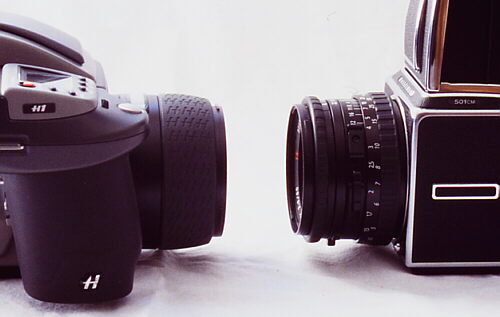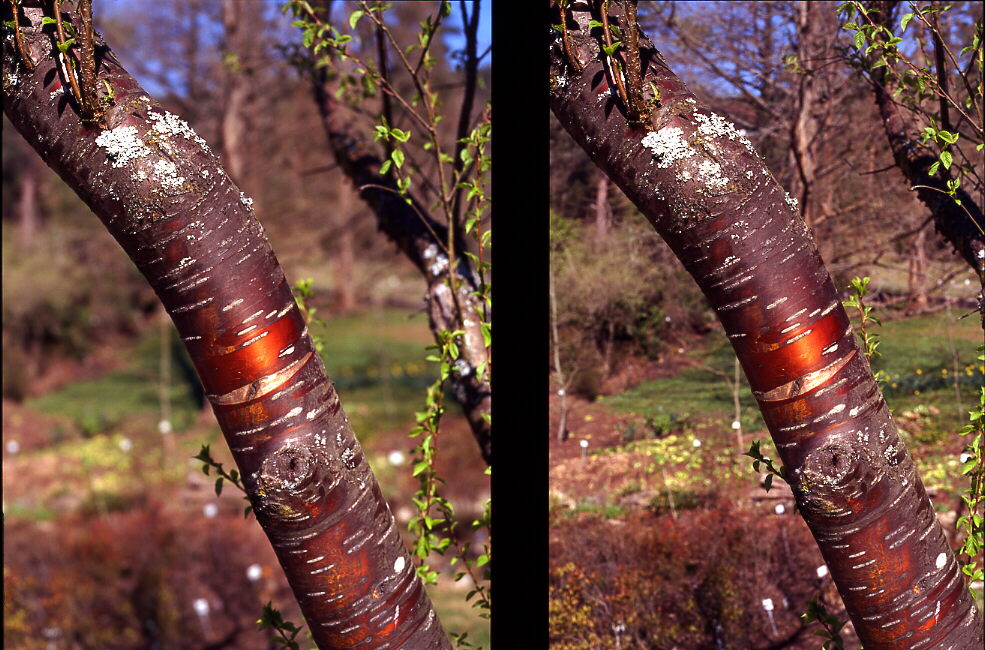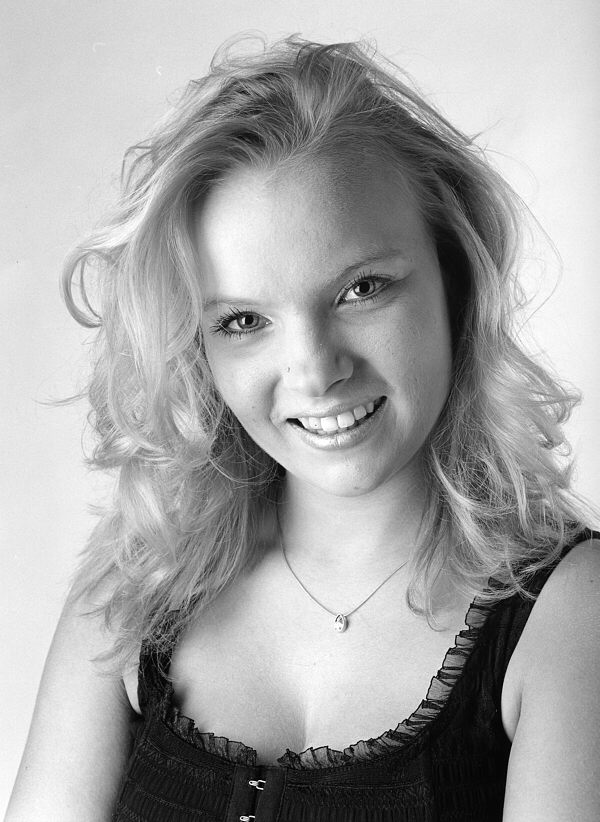
www.stefanheymann.de
German Version/Deutsche Fassung

Due to a friendly offer of the German Hasselblad Dealer Hassi-Foto GmbH, I was able to test a Hasselblad H1 for about a week. I used it for various subjects and with several types of film and I compared it with my own Hasselblad 501CM. This is a report of what I discovered in this week.
The kit I tested consisted of these parts:
I have compiled a small Gallery with detail views of the H1
The Hasselblad H1 is a modern, fully electronic single lens reflex (SLR) camera with autofocus for the 6x4.5 cm medium format. This is Hasselblad's first non-square MF camera. So this camera is not positioned against the classical 6x6 SLRs or the new Rolleiflex 6008AF but against the modern 645 cameras from Contax, Mamiya or Pentax (remember, the 645 market is larger than the 6x6 and 6x7 markets taken together).
After you switch it on (and select the appropriate [which is the default] automatic mode), the H1 behaves like a simple to use, Point & Shoot SLR. Everyone who has already worked with such a camera in 24x36 can instantly und inuitively use the H1. It just feels like a somewhat larger and heavier 24x36 SLR.
A "Quick Start Guide" is included along with the manual. With that, you can assemble the camera in a few minutes and have it ready for operation. Loading of the back is easy because Hasselblad has printed arrows onto the back insert which show how you have to insert the film roll. (With the V-Series siblings of the H1, loading a film back can be a sort of science of its own, so the Hasselblad designers have obviously done their best to keep it simple this time ;-) Putting on the lens is exactly the same as with the V-Series cameras.
When I first looked through the finder I instantly noticed how bright it was. Even though you can clearly see that there are sensors for exposure or focussing printed directly onto the mirror, the viewfinder of the H1 is very bright. Underneath the image in the finder there is a display which shows the most important information.
The H1 has been designed as a digital tool from the beginning. There is a data bus running through the whole system from back to lens which also has a special connector on the body so you can connect extension devices to the bus. With a digital back, you can even show the histogram (distribution of brightness) of the current scene on the main display (I couldn't test this cool feature because I didn't have a digital back ...).
Like with any new gadget, you have to get used to the handling. But this won't take long if you already have experience with fully electronic cameras (and who does not have this experience in these times ;-)
The H1 handles good, in landscape as well as in portrait mode (when you hold it the normal way, you get landscape pictures). You can securely place it on a table with its rubber feet. When you take away the bottom plate, there is the classical Hasselblad tripod quick mount plate. Yes, with that you can mount the H1 on every Hasselblad quick mount (and this is about the only compatibility I found between the H-Series and the V-Series).
The lens has an outer bayonet to which you can attach the lens shade which comes together with the lens. You can also reverse the lens shade so you can carry it without losing space.
The H1 is an autofocus camera. I can't compare it to another autofocus medium format camera, but for me, the autofocus is very fast and exact, especially for an MF camera. A great detail: if you want to switch from autofocus to manual focus, you don't have to turn a lever, you just turn the focusing ring. The camera realizes that the ring has been turned and stops focusing automatically.
If you want to use the autofocus again, you just release the release button and tap it again. For special applications, you can switch off autofocus completely. When it's too dark, the H1 uses a red light to support focusing.
There are three modes for exposure metering: Spot, Center and Average.
For selection of items in the various menus there are two wheels. With these, you can navigate quickly through the menus. For the most important things, you don't have to dig into deeply nested menus, you can directly select them using dedicated buttons.
A beautiful detail: You can use the release button as the OK or Save button in the menus which I found to be very intuitive. (But it's also somewhat dangerous: if you're not careful you can trigger the camera ;-)
After a few seconds of non-use the H1 goes to a sleep mode. There is a large H1 logo on the display and you must wake up the camera using the release button.
As a "P&S on steroids", the H1 is especially suited for taking pictures of people. I took a lot of photos of my children. Usually with the manual focus of the 501CM this is somewhat difficult ...
When using the H1 indoors, you can pop up the little flash. For studio use there is a traditional PC socket.
Two easily reachable buttons on the front of the camera are responsible for mirror lockup (M.UP) and stopping down the diaphragm to the preset value (STOP DOWN). The H1 does not have a a thread for a cable release. So for long time exposures (landscape photography) you will need a special electronic cable release.
Hasselblad has chosen Fuji as the supplier of the H1 lenses. This has led to a lot of discussions among the Hasselblad user community which to a large part likes Hasselblad because of their selection of Carl Zeiss as the primary lens supplier. A lot of discussions has dealt with the question whether the (admittedly sharp) Fuji glass has a good "bokeh".
Bokeh is the word for the rendition of the out-of-focus areas in a photograph. Zeiss lenses are known for a smooth bokeh. One of the first photos made with the H1 which was shown on the Web, Figure 3 in Michael H. Reichmann's test on photo.net, became famous for showing really terrible bokeh.
So I have taken a few photos with different f-stop settings (keep in mind that these photos are scanned from transparencies and compressed with a lossy compression):



Tree, Botanic Gardens, Tübingen University, Germany
Hasselblad H1, Hasselblad HC 80 mm

Tree, Botanic Gardens, Tübingen University, Germany
Hasselblad 501CM, Carl Zeiss Planar CB T* 2,8/80 mm

Asian Cherry Tree, Botanic Gardens, Tübingen University,
Germany
Hasselblad H1, Hasselblad HC 80 mm
In the studio, where you can use the camera hand-held due to the flash, you can feel the real qualities of the H1. With its autofocus and transport motor you are always ready for a shot. And I can't distinguish the technical quality of the H1 pictures from the pictures made with my 6x6.
Together with a friend we have tested the H1 and a Mamiya 645 in the same session. We have not been able to see any significant differences between the Hasselblad HC lens and the Mamiya Sekor lens on a 24x30 cm print (9.5x12")

Conny. Hasselblad H1, Hasselblad HC 80 mm
There are a few things - good and bad - I have noticed. In no particular order:
The film back has its own display, showing film speed, film length, and the film counter. Using a button on the back, you can back light the display. When the back is attached to the camera it is difficult to read the display because it is partly concealed by the prism. However, all the important information is also available on the main display of the body.
The maximum exposure time is 18 hours and 12 minutes (every IT nerd instantly notices that this are nearly 2^16 seconds ... :-)
The camera has a B and a T mode.
You cannot attach a back whose darkslide is opened.
But: you can detach a back with an open darkslide (however, I didn't test this with a loaded film back).
NOTE: This is an obvious fault which will be corrected by Hasselblad without costs.
In order to place the H1 on a tripod (using either one of the tripod threads or the Hasselblad quick release system) you must put off the bottom rubber plate. But then the H1 is lacking its rubber feet so you cannot comfortably place it on a table. At the V-Series there is no detachable bottom plate and the rubber feet are always on and usable.
When you hold the H1 in its normal orientation (landscape), the left thumb (or at least my left thumb, I have quite small hands) is positioned right on the bayonet release button. Although I didn't accidentally press this button, I always feared that this could happen. So please, Hasselblad, put it back where it belongs, to the front of the body.
The 80 mm lens comes with a lens shade and a leather bag. You can reverse the lens shade and put it on the lens so it saves room when you pack your camera into your bag.
The lens cap is somewhat cheap. It is quite stable, but I always had trouble putting it on and off.
With the prism and the hand grip, the H1 is quite large in your bag. It was difficult to find a place for it in my backpack (Lowepro MiniTrekker). My normal photo bag, where the 501CM fits without problems, is too small for the H1. So, when you plan to buy an H1, you should also plan to buy a new photo bag ...
The H1 does not have a thread for a traditional cable release. Come on, this can't be that difficult, boys ...
Multiple exposures are easily made. As soon as the H1 is in MLU mode, you can fire it as often as you want (and very silently). You don't have to detach the back for that, so you can make very exact multi-exposures.
In the menu, you can use the shutter release button as the "OK" button. I found that to be very intuitive.
The 80 mm lens doesn't have a bayonet for filters but a normal E 67 filter thread. So you can use less expensive filters ...
I have done some tests with a linear polarizer (Heliopan). No problems, even though the H1 has automatic metering and autofocus.
Compared to loading an A12 back (V-Series), loading the H1 back is easy. (Indeed, when I next loaded another film to my A12, I forgot to put the film under the silver tab and, well, er, I ruined the film ... :-(
When you work in the studio the flash cable hangs down from the PC socket on the left side of the body so it gets in the way of your left hand which I found to be somewhat disturbing. Perhaps Hasselblad should look for another place for the PC socket (why not at the lens like it used to be with the V-Series?). There is no lock lever for the PC plug like in the modern CFE/CB lenses.
I didn't have any trouble using an Ilford spool (old style) as the takeup spool ...
The firmware got stuck two or three times during the week. You can "reset" the H1 by detaching the battery hand grip. One time I had to keep it removed for a few seconds in order for the H1 to reset. (It seems there are still a few bugs in the firmware ...)
When the darkslide is closed you can not fire the shutter. Instead, there is a display message saying "The Darkslide is closed".
It never bothered me that the H1 is not a 6x6 (Ok, I don't force myself to always print the whole frame anyway).
In a somewhat undescribable way, the H1 is not a real Hasselblad
BUT:
The H1 is a really solid, great camera. It is fun to use it and to work with it. It has a fast autofocus, handles well and makes good photos. It's just a completely new generation of cameras for Hasselblad. I can imagine that the H1 will be succeeding, because you can instantly use it to make real medium format photos with it.
The H1 is not for you if you want to take landscapes using a sturdy tripod and a "reduced to the max" fully mechanical camera. The H1 is made for people photography, be it portraiture or wedding photography. It is much more spontaneous than a V-Series camera und this has advantages: you use the H1 for subjects and images you would't even thought about using the 501CM for.
The fault that you can detach a back with an open darkslide will be repaired without costs by Hasselblad.
I have been using the H1 for weddings all this season.
Lenses seem as good as my V camera lenses.
I hate the film loading. You must match the unused roll to the sprocket instead of a plain stud. I have been embarassed to not be able to load film without several tries on many occasions.
Auto focus in low light is a joke. My Fuji S1, based on a $250 amateur Nikon is infallible, but my $6K Blad doesn't work. Needs a white light assist.
It is easy to activate the flash by mistake. If a radio slave is on the body, it obscurs the fact that the flash is up, & you get an insufficient flash message instead of a shot. Tape the damn thing down. The cover on the diagnostic contacts falls off. Tape the damn thing down. The mirror up button is easily tripped by mistake because it is next to the stop-down. All of a sudden 100 people are watching you try to figure out why you can't see through your camera. Tape it over. The rubber eye cup is attached with glue. It will get knocked off & lost on the job, believe me. Screw it to the plastic underneath or attach velcro tabs with eyelets so you can attach it to the camera with velcro spots.
If you do not insert the film insert all the way & are in a noisy situation where you can not hear the film winding on, or fail to feel for the vibration of the winding on, the shutter will fire on a non-moving paper leader until you realize what you have done, causing you to lose many shots.
The power supply is insufficient. Often the low batt symbol will show after a couple of rolls. Then when they cool, the low batt will disappear. The question is always whether to ignore it or not. When the batteries are really too low, your Hasselblad is dead in the water. Better to count exposures than to trust the electronics.
I have seen a few first impression reviews. However, there is nothing like being on the job for extensive periods of time to find out what can
really happen to you. The old c and cm cameras had the most brilliant lenses and most gawdawful viewing system in the world. Everyone hates
trying to focus these cameras & having to explain to clients why focus is so bad. The viewing system in the H1 is so beautiful I could cry,
sharp, clear, bright. I (illegally) modified my 35 mm lens to fit the telextender, & even with the resulting 60 mm f6.3 lens I can focus it
better than a 2.8 on a cm.
Unfortunately this camera was brought out without having the bugs removed. Things just do not fall off a cm. My H1 is covered with black
tape just to keep it together. As far as bringing out a "people picture" camera with the availability of a 50 mm lens at least a year
away & a 60 mm lens not even projected, I am wondering why. I feel fortunate to have been able to get ahold of an extra magazine and a
telextender so I can even work. I personnaly have been glad to ditch square for rectangle. Square just made me lazy. At last I am really
composing. About time, I got my first c in 1972.
Another item [...] is the shutter speed wheel which always seems to get bumped to a higher speed by mistake. I will be
shooting a set of outdoor formals at 125th at f 8 & be horrified to look at the camera & see 350th on the dial. How long have I been 1 1/2 stops
under! I just put 2 velcro spots on either side of the wheel with a narrow velcro strip over them that I can flick on and off with my thumb. I don't care if I could lock the exposure electronically. I don't
want to be a computer operator when I am dealing with a petulant bride & her Wagnerian mother.
A Hasselbald exec might retort to my comments with the opinion that I am a new user who is not yet used to using the equipment. That argument
would hold some water, but shouldn't the new user have the proper warnings to avoid disasters? I was (fortunately) level-headed enough on
2 occasions to realize that I had hit the mirror-up button by mistake & to put it back down to continue working. Another photographer might
panic & go to the back-up camera right away, (provided it hadn't been left with the hotel concierge 2 miles away!).
I have received this e-mail in July 2003. The writer doesn't want his name to be mentioned here, because he wants to keep his good relationship to Hasselblad service. However, I find this "real life" experience so interesting that I post it here. Stefan.
All Photographs on this page have been scanned with an Epson Perfection 1640 Photo, using the Epson Twain Driver version 5.53G. Slide film: Agfa RSX II 100 (the somewhat strange brown tones are not a fault of the H1 but a result of my weak scanning skills). B&W film: Agfapan APX 100, developed in Rodinal 1+50, printed on Ilford Multigrade IV RC Pearl, scanned from 24x30 cm (9.5x12") print.
Thanks to Frau Hoeppner from Hassi-Foto for providing the H1, to Alexander Röhlich for providing the studio and the model. Special thanks to my wife for tolerating my Hasselblad spleen ;-)
An additional thanks to Curtis Hight who was so kind to correct my English in this text.
I appreciate any comments on this report to bladrunner@stefanheymann.de
Stefan Heymann